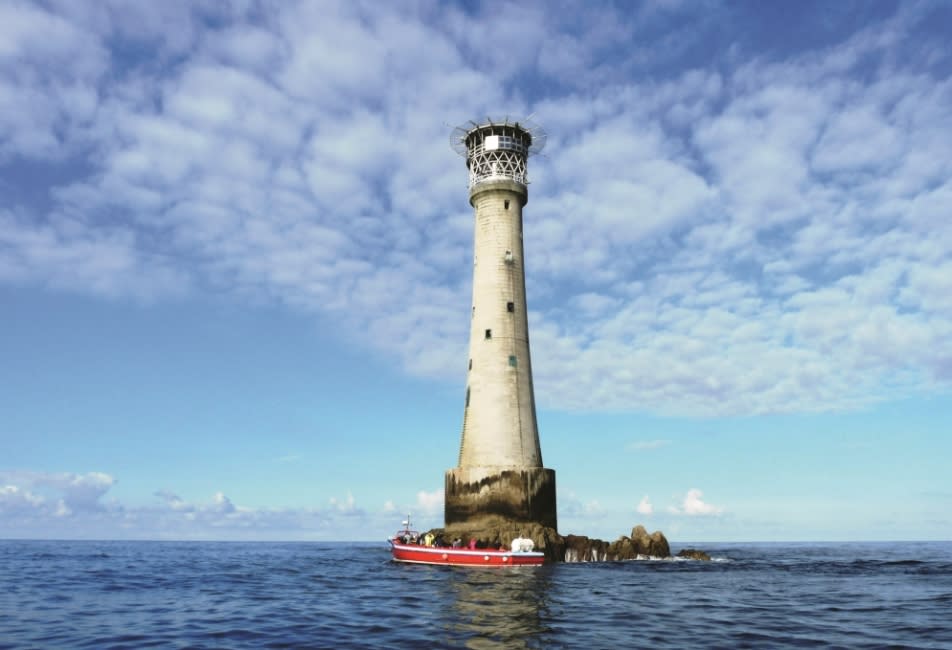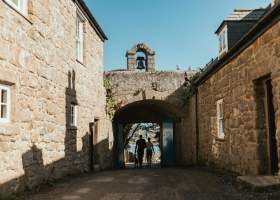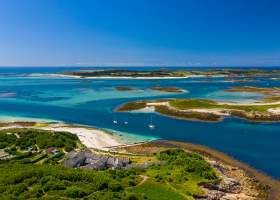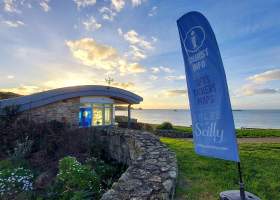Four miles west of the Isles of Scilly in the Atlantic Ocean stands Bishop Rock Lighthouse, built in 1858 to mark a rock ledge 45 metres long and 16 metres wide – the islands’ most westerly danger.
Statuesque and majestic, it stands at the very edge of England – a pillar of strength that now protects seafarers from the dangers that lie ahead as they approach the rocky archipelago. At the time of its build, it was (and would still be today) one of the most hazardous and difficult sites for a building of a lighthouse.
And so it was, a dream finally fulfilled – after 10 years of visiting Scilly and marvelling at it from afar: to take a boat to see Bishop Rock Lighthouse in all its glory. Weather conditions were on side with spectacularly calm seas and wall-to-wall June sunshine!
Family assembled, we boarded the Sapphire (one of the St. Mary’s Boatmen’s Association launches) with Joe Pender at the helm. We headed first to Annet, travelling the length of this protected island, Joe skilfully steering the boat through rocks incredibly close to shore so that we could enjoy the circling puffins, sand eels dripping from their beaks, and Guillemots and Razorbills clinging to the rock face, basking in the summer warmth.

Fulmars, shags, cormorants and diving gannets were also a plenty, as we headed west towards the Western Rocks via Rosevear, a tiny island where, two hundred years ago, two lonely houses were built to home those working on the Bishop Rock Lighthouse build. Remote and isolated are two words that put it mildly; how they survived out there on an island no bigger that a postage stamp defies belief and to think they rowed to work and back every day! What brave men indeed. Today you can still see the gable end remains of the houses, and the tiny slip built into the rocks.
Next up, the beautiful Atlantic Grey seals – ducking and weaving in the wash of the Western Rocks. These intelligent, playful animals certainly know how to put on a show as they tease you with glimpses from the water or laze on the rocks, almost inviting you to tickle their tummies as they wait for the rising tide!
And then the voyage to the Rock itself, on the way learning about the many shipping disasters, the biggest of them in 1707 with the loss of four Royal Navy warships in appalling weather - HMS Association, HMS Eagle, HMS Firebrand and HMS Romney – and 2,000 lives. Thomas W. Lawson was another. She was built in 1902, a seven-masted, steel-hulled schooner – the largest sailing vessel ever built without an auxiliary engine. She was wrecked off the island of Annet in 1907. The list goes on – Scilly has the ominous claim of having one of the highest concentrations of shipwrecks anywhere in the world – over the centuries about 900 in total! So, as we approached the lighthouse, standing 49 metres tall, its importance was all too apparent.
Bishop Rock lighthouse is, in fact, three in one. The first, a screw-pile lighthouse was started in 1847, completed in 1849 and swept away in heavy gales in 1850. Undeterred, Trinity House designed a second one – this time a granite tower built on a solid landmass 10 metres in diameter. This structure, standing 35 metres tall was completed in 1858 but even by 1881, storm damage had weakened it to such an extent that it was determined to strengthen the tower and increase its elevation. Essentially, a new lighthouse was built around the old one. Work was completed in 1887.
Lighthouse keepers manned Bishop Rock Lighthouse until just 25 years ago in 1992, after it was converted to automatic operation during 1991. It’s incredible to imagine how they lived in the tower, even climbed to its entrance to be honest, and lived fearlessly to keep the islands safe.
St. Mary’s Boatmen’s Association and St. Agnes Boating run regular trips to Bishop Rock Lighthouse (taking in seabirds along the way) during the summer, weather permitting.
It’s incredible to imagine how they lived in the tower and lived fearlessly to keep the islands safe.










